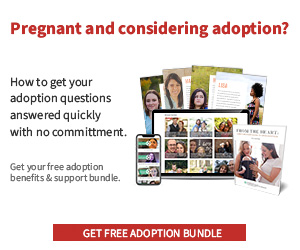Understanding Positive Adoption Language
Over the years, adoption language has made a shift to be more sensitive and compassionate to those involved in the process. Rather than using phrases such as “give up” or “put up” for adoption, we strive to correctly refer to “placing” a child for adoption. We understand that the decision to make an adoption plan and place a baby is significant for all involved. Birth mothers do not “give up” when they choose to place their children in a family of their choosing. Open adoption practices have caused a shift in adoption triad relationships allowing for contact to be maintained post-placement. As we work together to use positive adoption language, we can inspire deeper understanding and empathy for those who make the difficult decision to pursue adoption and maintain positive relationships.
How Easy Is It to Give Up a Child for Adoption?
Adoption is a profound and compassionate act that involves placing a child in the care of adoptive parents. People consider placing a baby for adoption for various reasons including financial instability, personal circumstances, or a desire to provide the child with a safe, stable home. No matter the reason, the process, emotionally, is not easy. Because of that, adoption professionals do everything in their power to make the process run as smoothly as possible as far as logistics go.
What does the adoption process look like for birth mothers? The adoption process for birth mothers involves several steps:
- Making the Decision: Birth mothers carefully consider their options and decide whether adoption is the best choice for themselves and their child.
- Choosing an Adoption Agency or Attorney: Birth mothers work with adoption professionals to navigate the legal and emotional aspects of the adoption process.
- Creating an Adoption Plan: Birth mothers collaborate with the adoptive family to outline their preferences for the child’s future, including the desired level of contact and involvement.
- Prenatal Care and Support: Birth mothers receive medical care and emotional support throughout their pregnancy from adoption professionals and healthcare providers.
- Birth and Placement: When the baby is born, the birth mother may choose to have the adoptive family present. After birth, the child is placed with the adoptive parents.
- Legal Proceedings: Legal procedures finalize the adoption, ensuring that the child’s placement is legally recognized.
- Post-Placement Support: Birth mothers receive ongoing emotional support and resources to cope with the aftermath of placement.
What does the adoption process look like for adoptive parents? The adoption process for adoptive parents follows a similar pattern:
- Choosing an Adoption Agency or Attorney: Adoptive parents select a reputable adoption agency or attorney to guide them through the process.
- Completing a Home Study: Adoptive parents undergo a home study to assess their suitability and readiness to adopt.
- Creating a Profile: Adoptive parents create a profile to introduce themselves to expectant parents considering adoption.
- Matching with a Birth Mother: Adoptive parents are matched with a birth mother based on mutual preferences and compatibility.
- Supporting the Birth Mother: Adoptive parents provide emotional support to the birth mother throughout her pregnancy.
- Finalizing the Adoption: Legal proceedings formalize the adoption, granting legal custody of the child to the adoptive parents.
- Post-Adoption Support: Adoptive parents receive ongoing support and resources to navigate the challenges of parenthood.
Life for Birth Mothers Post-Placement
After the placement of a child for adoption, birth mothers often find themselves navigating a complex array of emotions and practical considerations.
Legal Aspects: Firstly, there are the legal aspects to plan for. Depending on the specifics of the adoption arrangement and the laws of their state, birth mothers will most likely complete parental termination paperwork at the hospital after the birth of the child. There is typically a waiting period between the birth and signing paperwork. Work with your adoption agency to know what to prepare for and if you have any specific needs or preferences for this portion of your adoption plan. Understanding these legal implications is crucial for birth mothers as they move forward after placement, ensuring they are aware of their rights and obligations within the adoption process.
Maternity Leave: The transition from pregnancy to post-placement life may raise questions about employment and maternity leave. Just because you make an adoption plan, you do not forfeit a need for maternity leave. Speak with your employer and HR representative openly about your plans and need for leave surrounding your pregnancy and delivery. Navigating these practical considerations alongside the emotional aftermath of placement can be challenging, underscoring the need for comprehensive support systems for birth mothers during this time of transition.
Contact in the First Year: Furthermore, maintaining contact with the adoptive family can be a significant aspect of the post-placement experience for birth mothers. Through letters, emails, phone calls, or visits, birth mothers and adoptive families may choose to stay connected, as agreed upon in their adoption plan. This ongoing contact can provide birth mothers with reassurance and peace of mind as they witness the growth and development of their child while also fostering a sense of connection within the extended adoptive family. However, navigating these dynamics requires clear communication and mutual respect between all parties involved, ensuring that the best interests of the child remain paramount throughout the post-placement journey.
What does adoption look like for the child after placement? Children bond with their adoptive parents through love, care, and nurturing. Open adoption can provide adoptees with a sense of identity and connection to their birth family, as they grow and develop. Immediatly after placement, the adoptive family may choose to have a period of cocooning. This is normal and gives the child and parent time to bond. Communication between the birth and adoptive parents about this practice before the birth is crucial for establishing expectations and a foundation of positive communication.
How do you navigate open adoption? Open adoption involves ongoing communication and cooperation between birth parents and adoptive parents. Setting boundaries, establishing trust, and fostering open lines of communication are essential for a healthy and successful open adoption relationship.
Pregnant and considering adoption?
Get your free adoption benefits and support bundle

Learn more about open adoption.
What does post-adoption support look like? Post-adoption support includes professional counseling, support groups, and resources for adoptive families and birth parents. Family and friends also play a crucial role in providing emotional support and practical assistance. Additionally, self-care is essential for adoptive parents and birth mothers to prioritize their mental and emotional well-being.
How Easy Is It to Give Up a Child for Adoption?
It’s essential to acknowledge that adoption inherently involves loss for all parties involved. Birth mothers grapple with the loss of their biological connection with their child, adoptive parents may mourn the inability to conceive biologically, and adoptees may experience a sense of loss stemming from separation from their birth family. Recognizing and validating these feelings of loss is paramount in creating a supportive and empathetic adoption experience. By acknowledging and processing these emotions openly, all individuals within the adoption triad can better navigate the complexities of their respective roles, fostering understanding, healing, and ultimately, stronger relationships built on empathy and mutual respect.
Placing a child for adoption is a significant and often challenging decision, but it can also be a deeply rewarding and loving choice. By understanding the adoption process from every angle and embracing positive adoption language, we can support and empower birth mothers, adoptive parents, and adoptees on their journey to creating forever families.
Questions? Ready to make an adoption plan? Visit Adoption.com/support for more information or to speak with an Adoption.com team member.
How Easy Is It to Give Up a Child for Adoption?


